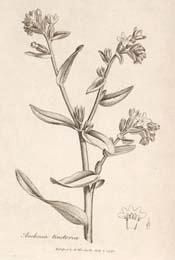

|
Tausch, Alkanna
(Alkanna tinctoria LINN.)
|
Alkanets
Botanical: Alkanna tinctoria (TAUSCH.), Lithosfermum tinctorium (VAH L.)
Family: N.O. Boraginaceae
---Synonyms---Anchusa. Dyer's Bugloss. Spanish Bugloss. Orchanet.
---Part Used---Root.
The name Anchusa is derived from the Greek anchousa=paint, from the use of the root as a dye.
The species are hispid or pubescent herbs, with oblong, entire leaves, and bracteated racemes, rolled up before the flowers expand. The corolla is rather small, between funnel and salver-shaped; usually purplish-blue, but in some species yellow or whitish; the calyx enlarges in fruit. The root, which is often very large in proportion to the size of the plant, yields in many of the species a red dye from the rind.
Alkanet (A. tinctoria) is cultivated in Central and Southern Europe for its dye, which is readily extracted by oils and spirit of wine. It is employed in pharmacy to give a red colour to salves, etc., and in staining wood in imitation of rosewood, or mahogany. This is done by rubbing it with oil in which the Alkanet root has been soaked. About 8 to 10 tons were annually imported from France and Germany. The plant is sometimes also cultivated in Britan, but by far the greater portion of the Alkanet used here is imported either from the Levant or from the neighbourhood of Montpellier, in France.
Though Alkanet imparts a fine deep red colour to oily substances and to spirit of wine, it tinges water with a dull brownish hue. Wax tinged with Alkanet, and applied to the surface of warm marble, stains it flesh-colour and sinks deep into the stone. It is also used in colouring spurious 'port-wine,' for which purpose it is perfectly harmless.
Our British species, the Common Alkanet (A. officinalis), is a soft, hairy plant with an angular stem, narrow, lanceolate leaves; and forked, one-sided cymes of violet flowers; calyx longer than the funnel-shaped corolla. It is an occasional escape from gardens. It is a biennial, and flowers from June to July.
The Evergreen Alkanet (A. sempervireus) is also found in Great Britain. This is a stout bristly plant, with deep green, ovate leaves, and long-stalked axillary, crowded clusters of rather large flowers, which are of an intense azure blue and have a short tube to the corolla. It is not generally considered a native, but it is not an uncommon hedgeplant in Devonshire. It is a perennial and flowers from May to August.
Parkinson says that the French ladies of his day coloured their faces with an ointment containing anchusa and the colour did not last long.
- ---Medicinal Action and Uses---Culpepper says:
- 'It is an herb under the dominion of Venus, and indeed one of her darlings, though somewhat hard to come by. It helps old ulcers, hot inflammations, burnings by common fire and St. Anthony's fire . . . for these uses your best way is to make it into an ointment also if you make a vinegar of it, as you make a vinegar of roses, it helps the morphy and leprosy . . . it helps the yellow jaundice, spleen, and gravel in the kidneys. Dioscorides saith, it helps such as are bitten by venomous beasts, whether it be taken inwardly or applied to the wound, nay, he saith further, if any that hath newly eaten it do but spit into the mouth of a serpent, the serpent instantly dies.... It also kills worms. Its decoction made in wine and drank, strengthens the back, and easeth the pains thereof. It helps bruises and falls, and is as gallant a remedy to drive out the smallpox and measles as any is; an ointment made of it is excellent for green wounds, pricks or thrusts.'
Common Name Index
A MODERN HERBAL Home Page
Purchase this Herb from Botanical.com
Bear in mind "A Modern Herbal" was written with the conventional wisdom of the early 1900's. This should be taken into account as some of the information may now be considered inaccurate, or not in accordance with modern medicine.
© Copyright Protected 1995-2004 botanical.com

|



